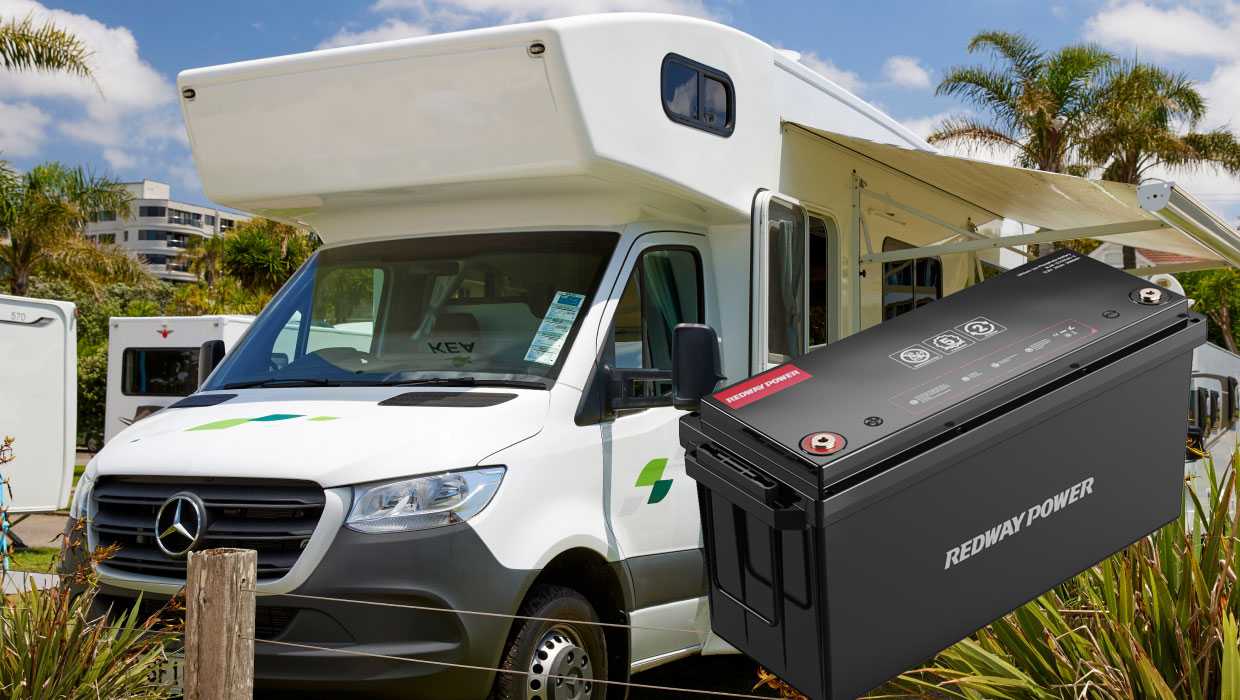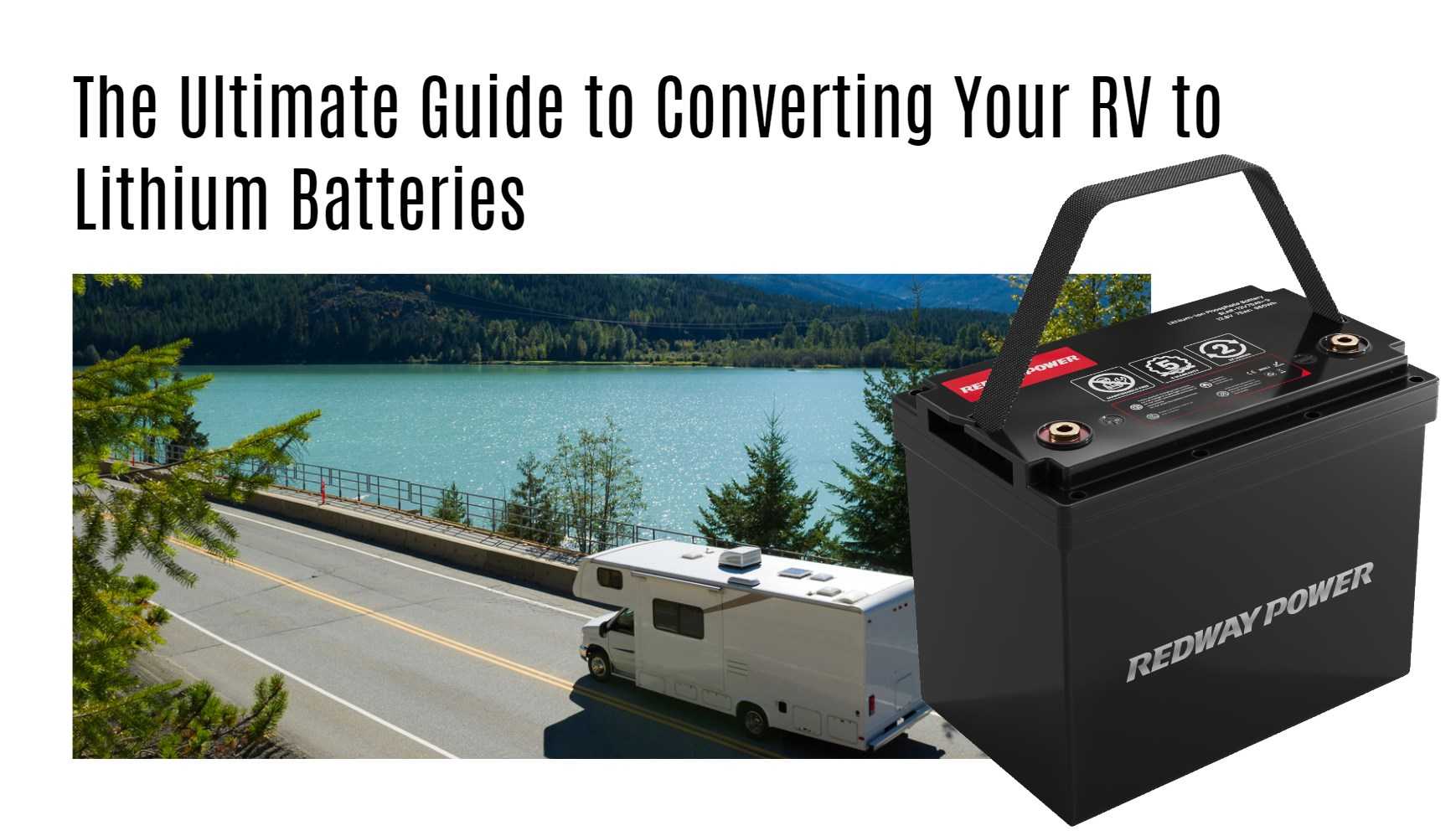Thinking about upgrading your RV to lithium batteries? Our guide covers all you need to know. Discover why Redway lithium batteries are the top choice, learn about their benefits, and find the right battery size. We’ll also touch on inverters, solar panels, charge controllers, and the best way to charge your lithium RV batteries. (Read: BCI Battery Group Size Chart Guide and BCI Group Battery Factory Wholesale)
Why Choose Redway Lithium Batteries for Your RV?
Upgrade your RV power system with Redway lithium iron phosphate (LiFePO4) batteries. Here’s why they’re the perfect choice:
- Maximized Usable Capacity: Redway lithium batteries provide 100% usable capacity, allowing you to run all your electronics with ample reserves, even during boondocking.
- Zero Maintenance: Forget about watering and maintenance hassles—Redway lithium batteries require no upkeep, unlike traditional lead-acid batteries.
- Consistent Power: Experience constant and reliable power without voltage sag, ensuring optimal performance for all your RV needs.
- Easy Replacement: Redway offers drop-in replacements with standard-sized BCI cases, making it simple to upgrade your RV batteries hassle-free.
- Extended Lifespan: Enjoy up to 10 times the lifespan of lead-acid batteries with Redway lithium batteries, still providing 80% capacity after 2,000 cycles.
- Partial State of Charge Tolerance: Redway lithium batteries perform consistently, even with partial charging—an issue that often affects lead-acid batteries.
- Safety and Reliability: Designed by a team with over 200 years of combined experience, Redway batteries are manufactured in ISO 9001:2015 certified facilities, ensuring top-notch quality and performance.
- Environmental Commitment: Redway is dedicated to environmental sustainability, contributing 1% of annual revenue to environmental nonprofits through 1% for the Planet. Upgrade to Redway for a powerful, reliable, and eco-friendly RV adventure!
Selecting the Right Battery Size for Your RV:
Redway offers 12V, 24V, 36V and 48V lithium batteries in various BCI standard sizes. The following are some popular RV batteries and their power capacities.
To determine the right battery size for your RV, you need to calculate your energy needs based on the power requirements of your appliances and devices. Redway’s Lithium Battery Selector Tool can assist you in finding the optimal battery for your specific application and usage.
How to Choose the Best RV Inverter?
If you’re new to RV living, understanding inverters is key. Here’s a quick breakdown:
- Inverter Basics: Inverters are essential for AC-powered devices in RVs, transforming stored DC power into the AC power needed for household appliances. While RVs come with onboard DC batteries for lights and built-ins, an inverter is required for larger appliances like microwaves or non-built-in fridges.
- Solar Power Integration: When using solar panels, energy collected needs to pass through an inverter for use. If you have a solar generator like EcoFlow, it often comes with a built-in inverter. For DIY solar systems, a standalone inverter is necessary.
- Choosing the Right Size: The best inverter size depends on your RV’s size, the number of power-hungry appliances, and how many electronic devices you’ll run simultaneously. Consider these factors for an optimal RV power setup.
How to Install Your RV Inverter?
Before installing your RV inverter, assess your power needs based on the appliances you’ll run. Here’s a simplified guide:
- Choose the Right Size: Consider your power requirements—small 12-volt inverters suit basic needs, while larger appliances may need higher voltage inverters. Once chosen, make space in your RV, especially for larger inverters.
- Installation Methods: Small inverters can plug into the cigarette lighter, but larger ones require wiring and grounding. For larger installations, it’s advisable to seek help from an electrician if you’re not comfortable with the installation process.
Solar Panels and Charge Controllers
Considering solar power for your RV? Here’s what you need to know about charge controllers:
- Essential Component: To regulate energy flow between the solar array and battery, a charge controller is crucial for any RV solar setup.
- PWM vs. MPPT: Choose between Pulse Width Modulation (PWM) and Maximum Power Point Tracking (MPPT) controllers. PWM functions as an on/off switch, while MPPT maximizes charging efficiency by monitoring both solar array and battery voltage.
- Decision Factors: Evaluate your power generation, expected usage, and environmental conditions before purchasing a controller. This information guides the selection of the most suitable charge controller for your RV solar system.
How to Charge Lithium RV Batteries?
Ensure optimal performance and longevity for your LiFePO4 batteries with these key charging tips:
- Use a Dedicated Charger: Only employ chargers designed specifically for LiFePO4 batteries to avoid potential damage caused by higher voltage settings in chargers meant for other lithium-ion chemistries.
- Charging Frequency: LiFePO4 batteries don’t need to be charged after each use. Charging them after being discharged up to 80% depth of discharge (DOD), leaving 20% state of charge (SOC), is sufficient. They are not affected by partial state of charge (PSOC).
- Storage Recommendation: Store lithium batteries at a 50% state of charge (SOC) to minimize irreversible capacity loss over time.
- Fuel Gauge Consideration: If using a voltage-based fuel gauge designed for lead-acid batteries, opt for one that measures current rather than voltage for accurate monitoring of LiFePO4 batteries.
Top 10 Questions and Answers for Lithium Battery Buyers:
1. Are lithium batteries safe for RV use?
Yes, lithium batteries are safe for RV use. They are equipped with built-in safety features, such as thermal protection and management systems, to ensure reliable and secure performance. Modern lithium batteries have undergone extensive testing and advancements, making them a trusted and efficient power source for RV applications.
2. Can I use my existing inverter with lithium batteries?
In most cases, you can use your existing inverter with lithium batteries. However, it’s crucial to ensure that the inverter is compatible with the voltage range of lithium batteries for optimal performance. Confirm the specifications and requirements of both your inverter and lithium batteries, and consider consulting with Redway’s experts for guidance on achieving seamless compatibility for your RV power system.
3. Do I need to replace my existing solar charge controller when switching to lithium batteries?
While some existing solar charge controllers work with lithium batteries, it’s advisable to check compatibility or consider upgrading for better efficiency and battery health. Lithium batteries have specific charging characteristics, and using a controller designed for them ensures optimal performance, preventing overcharging or undercharging. Consult the manufacturer’s guidelines for compatibility information.
4. Can I charge my lithium batteries with a standard lead-acid battery charger?
It’s not recommended to charge lithium batteries with a standard lead-acid battery charger. Lithium batteries have specific charging requirements, and using a charger designed for lead-acid batteries may not provide the necessary precision. To ensure safe and efficient charging, it’s advisable to use a charger specifically designed for lithium batteries, following the manufacturer’s guidelines.
5. How long do Redway lithium batteries last?
Redway lithium batteries have an extended lifespan, lasting up to 10 times longer than lead-acid batteries. They typically maintain 80% of their rated capacity even after 2,000 charge-discharge cycles. This durability ensures a reliable and long-lasting power source for your RV, contributing to cost-effectiveness and reduced maintenance needs.
6. Can I use lithium batteries in cold weather?
Yes, lithium batteries perform well in cold weather. They have better cold-temperature performance compared to lead-acid batteries. While extreme cold can affect battery efficiency, modern lithium batteries are designed to operate effectively in a wide range of temperatures. It’s essential to check the manufacturer’s specifications for temperature limits and recommendations for optimal use in colder climates.
7. Are lithium batteries compatible with my RV’s existing wiring system?
Lithium batteries are generally compatible with existing RV wiring systems. However, it’s essential to follow the manufacturer’s guidelines and possibly make adjustments to accommodate the specific requirements of lithium batteries. Consult with Redway’s experts or refer to the battery manufacturer’s recommendations to ensure proper integration with your RV’s electrical system for optimal performance and safety.
8. How do I determine the right battery size for my RV?
To determine the right battery size for your RV, calculate your daily energy consumption, considering appliances and electronics. Choose a lithium battery with sufficient capacity, typically measured in ampere-hours (Ah), to meet your energy needs. Redway’s experts can assist in selecting the ideal size based on your specific requirements and usage patterns.
9. Can I use lithium batteries in parallel or series configurations?
Yes, lithium batteries can be used in parallel or series configurations for RVs, allowing customization of voltage and capacity. Follow manufacturer guidelines, connect in parallel for increased capacity, and in series for higher voltage. Use a battery management system for optimal performance, and ensure proper balancing for longevity.
10. Can I recycle my old lead-acid batteries when I switch to lithium?
Yes, it’s highly recommended to recycle your old lead-acid batteries when you switch to lithium. Lead-acid batteries contain hazardous materials, and recycling them is essential for environmental sustainability. Many recycling facilities accept lead-acid batteries and ensure that they are disposed of properly, preventing harm to the environment. Be sure to check with local recycling centers or battery retailers to find a suitable location for recycling your old lead-acid batteries.

Related Posts
- Redway LiFePO4 Battery One-stop Solution Introduced
- How to Choose Solar Panel Size Chart For RVs, Vans, Campers?
- How to choose a lithium battery for your RV, camper or Van
- Applications of 12V 100AH Lithium-Ion Batteries: A Comprehensive Overview
- Zapping the Voltage: A Simple Guide to Multimeter Testing for AAA Battery Voltage
- Will solid-state batteries replace lithium?





























